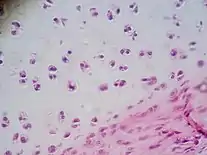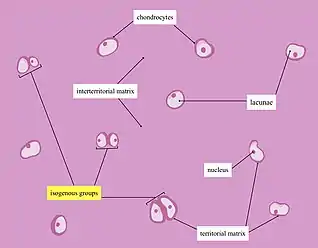Isogenous group
An isogenous group (lat. "equal origin") is a cluster of up to eight chondrocytes[1] found in hyaline and elastic cartilage.[2]

Micrograph of hyaline cartilage containing isogenous groups.
Formation
Chondrocytes develop in the embryo from mesenchymal progenitor cells through a process known as chondrogenesis.[2][3] A chondrocyte can then undergo mitosis to form an isogenous group within its lacuna.[3][4]
Function
Isogenous groups differentiate into individual chondrocytes where they continue to produce and deposit extracellular matrix (ECM), lengthening the cartilage and increasing its diameter.[3][5] This is termed interstitial growth and is one of only two ways cartilage can grow.[4]

Cartoon representation of hyaline cartilage with isogenous groups.
See also
- Endochondral ossification
- Hyaline
References
- Nahian, Ahmed; Sapra, Amit (2021), "Histology, Chondrocytes", StatPearls, Treasure Island (FL): StatPearls Publishing, PMID 32491508, retrieved 2021-11-28
- Wheater's Functional Histology, 6th ed. Young, O'Dowd and Woodford.
- Leboffe, Michael J. (2013). "Chapter 5: Cartilage and Bone". A Photographic Atlas of Histology Second Edition. Morton Publishing. pp. 51–55. ISBN 978-161731-068-3.
- Hall, Brian K. (2005), "Chapter 3: Cartilage", Bones and Cartilage: Developmental and Evolutionary Skeletal Biology, Elsevier, p. 35, ISBN 9780080454153, retrieved 2021-11-28
- Asanbaeva, Anna; Masuda, Koichi; Thonar, Eugene J.-M. A.; Klisch, Stephen M.; Sah, Robert L. (2007). "Mechanisms of cartilage growth: Modulation of balance between proteoglycan and collagen in vitro using chondroitinase ABC". Arthritis & Rheumatism. 56 (1): 188–198. doi:10.1002/art.22298. ISSN 1529-0131. PMID 17195221.
This article is issued from Wikipedia. The text is licensed under Creative Commons - Attribution - Sharealike. Additional terms may apply for the media files.